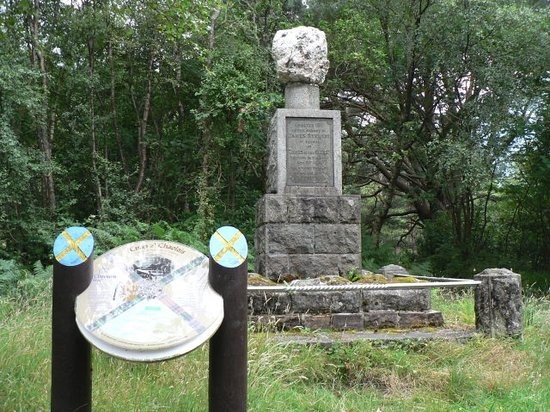Ballachulish (at the end of Glencoe) perched on the edge of Loch Leven is a monument. It was here in 1752 that a local man was hanged for a murder he didn’t commit. The man’s name was James Stewart of the Glen. Robert Louis Stevenson’s novel, Kidnapped fictionalises the Appin Murder with a cast of real historical characters, the true story here as far I can find from historical records: The date is 14th May 1752. The place, Lettermore Wood on the south shore of Loch Linnhe, near Ballachulish. Colin Roy Campbell of Glenure rides through the wood with three companions when a pistol is fired from a nearby hillside. The marksman is accurate. Campbell falls from his horse. He’s been shot in the back. His companions run to assist him as he lay dying. They see a man in a brownish grey coat fleeing over the hill but can’t make out his features. The murder is political. The Government is nervous. In the aftermath of the Battle of Culloden in 1746, George II was anxious to squash any further rebellion in Scotland. Culloden had been a devastating defeat for the Jacobites – but tensions were still high. The British Government imposed strict sanctions on all Jacobite sympathisers, one of which was to forbid the wearing of any tartan throughout Scotland. Other, more barbaric sanctions took place.
Prince William, Duke of Cumberland, third son of George II, (who became known as “Butcher Cumberland”) was the leading General of his day and he commanded the British army in the suppression, or as he called it, ‘pacification’ of the Jacobites. Thousands were rounded up after Culloden, killed, tortured, deported to the colonies, or simply ‘disappeared’. Livestock was confiscated and even wives were imprisoned along with their husbands. Colin Roy Campbell of Glenure had been appointed by the British government as a factor, managing the estates confiscated from Jacobite clans. Among the most obvious supporters of the House of Stuart were members of their clan, the Stewarts of Appin. The Stewart clan had their estates forfeited and Colin Roy Campbell was appointed to oversee the changeover. (Historical note; by the way, the spelling of ‘Stewart’, for the Stewart clan, is original to Scotland. Mary Queen of Scots changed the spelling to ‘Stuart’ when she lived in France, because the French found it easier to pronounce. (They tended to pronounce the ‘w’ as ‘v’). After that the Royal family continued to use Stuart instead of Stewart). James Stewart of the Glen, was enraged to find that members of his family were being targeted for an illegal evictions. He tried through the courts to prevent this from happening but with no success. At this time James Stewart’s foster son, Alan Breck Stewart came back from France, where he was serving with the French regiment. He had been in the British army but switched sides before the Battle of Culloden to fight for the Stuarts. After their defeat he had fled to France but now, six years later, was back in town, socialising, drinking and making loud threats about what he would do to Colin Roy. After Colin Ray was shot, suspicion fell on Alan Breck, especially as he fled town soon after and was never caught. Allegedly he escaped back to France. In his novel, Robert Louis Stevenson has Alan Breck meet up with his main character, David Balfour, to whom he denies all responsibility for the murder. They go on the run together into the highlands. There have been a few terrible films made of this book, using English actors!
With Alan Breck Stewart gone, they had to find someone to hang for the murder. George II the German was an unpopular monarch, preferring Germany to England. He was only on the British throne because he was the nearest related protestant in the royal line. So, many people saw as a travesty of justice Alan’s foster-father, James Stewart was tried for the murder and found guilty of conspiring to kill Colin Roy Campbell. The jury who tried him were a panel of Campbell clansmen, presided over by a Campbell judge, the verdict was a forgone conclusion. The evidence was scanty at best. He was hung for the murder and left there for all to see and the crows to peck at, as a warning to the highlanders, the saxons tied his remains together with wire so the body wouldn’t fall. In the end a local ‘halfwit’ could stand the sight no longer. He pulled down the gallows with the skeletal remains still attached, and threw it into the loch. It floated down stream, where the bones were rescued and buried by a family member, a young man named Donald Stewart of Ballachulish.
Legend says that the Stewart clan knew very well who the real murderer was and that this secret has been passed down through the generations. In 2001 Anda Penman, an 89-year old descendant of the Stewart clan decided it was time to break the silence. She claimed that four young highlanders had planned the murder. They held a shooting contest and the best marksmen among them then delivered the fatal shot. That marksman was none other than the one who buried the body, Donald Stewart of Ballachulish. The old lady died soon after, and her claim was not confirmed by any other member of the Stewart clan. About the same time, Lee Holcombe, an American professor of history, had just spent twenty years investigating all the evidence in this infamous unsolved murder case. She concluded that it was indeed Donald Stewart of Ballachulish who delivered the shot. She wrote a book about her findings: Ancient Animosity but died in 2002 before it reached a publisher. Her son took over the work of editing and her book was eventually published in 2004. Anda Penman, it seems, was telling the truth. The story doesn’t quite end there. In 2008 an undisclosed member of the Campbell family hired a lawyer to forward a submission to the Scottish Criminal Cases Review Commission which requested to have James Stewart’s guilty verdict overturned. On that occasion the request was declined, now there’s a thing, as we still have German royals in London.
The victim of the murder was James of the Glens (Gaelic “Seumas a’ Ghleann”), not “of the Glen”, who was the half brother of Stewart of Ardshiel, Captain of the Clan Stewart of Appin, and his tacks man and factor; Alan Breck was James’s half or foster-brother, not son; and the presiding judge was MacCailean Mor himself, Archibald, 3rd Duke of Argyll, chief of Clan Campbell, and Lord Justice-General (i.e. the most senior judge) of Scotland. What do you think? PAUL MCLEAN

